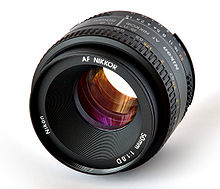Interchangeable lens
Interchangeable lenses are in the photo technique such lenses , which by a bayonet or screw on a camera body can be attached. Interchangeable lenses, together with the camera housing, form essential parts of a camera system . An aperture is usually included in the interchangeable lens ; the shutter is mainly located in the camera housing.
Lens adapters enable lenses from other manufacturers or lenses with different connections to be used.
Functions
The aperture is usually set manually with the help of an adjustment ring or automatically via the exposure control of the camera housing. More modern interchangeable lenses can automatically exchange aperture values with the camera technology in the housing, so that stopping down to adjust the aperture is superfluous. The focal length of zoom lenses can also be set using a setting ring , and on some models with an electric rocker switch or with the camera control.
Lenses of digital camera systems, which are usually equipped with their own data processor and firmware , can exchange additional data with the camera housing: In addition to the aperture values, usually the manufacturer, lens designation, serial number, software version, subject distance , as well as minimum, maximum and current focal length. With modern camera systems, the imaging errors that occur for different focal lengths and apertures ( edge light drop , chromatic aberration and distortion ) can also be transmitted.
Categories
Interchangeable lenses can be roughly divided into
A distinction must also be made between:
- Fixed focal lengths - offer only a single, fixed focal length, e.g. B. 35 or 90 or 200 mm; if you want to use different focal lengths , you need several individual fixed focal lengths. Fixed focal lengths usually allow a higher image quality than zoom lenses.
- Zoom lenses - lenses with a variable focal length. Zoom lenses arecharacterized, among other things, by their zoom factor and allow, for example, a focal length range from 28 to 200 mm to be bridged, that is, in 35mm photography from wide-angle to telephoto without changing lenses. They therefore allow a reduced amount of equipment and lower acquisition costs. However, compromises often have to be made in terms of light intensity and image quality compared to the corresponding fixed focal lengths. Due to the larger number of lenses due to the design, the image contrast is alsosomewhat lower
A further distinction between interchangeable lenses is possible according to the following criteria:
-
Connection to the camera body
- Screw thread , e.g. B. M 39 or M 42
- Various, mostly incompatible bayonet connections from the camera manufacturers
- Focal length or focal length range :
-
Luminous intensity , i.e. the largest or smallest possible aperture or maximum or minimum luminous intensity:
- Fast lenses with initial apertures in the range of about F1: 1.2 to F1: 2.8,
- Standard lenses with starting apertures in the range of about F1: 2.8 to F1: 5.6,
- Faint lenses with initial apertures from about F1: 5.6.
-
Application area and purpose :
- Portrait lens
- Macro lens among others
-
Various other design and equipment features such as autofocus, internal focusing, integration of an ultrasonic motor for automatic focusing, an electronic function that automatically compensates for camera shake ( image stabilization ), etc.
- Autofocus lens
- Mirror lens lens
- Shift lens
- Tilt lens among others
Interchangeable lenses with outstanding design features or narrowly limited areas of application are also referred to as special lenses ; Examples are macro zoom lenses as well as shift lenses and tilt lenses.
literature
- Christian Westphalen: The big book of lenses. Technology, equipment and photographic design. Rheinwerk, Bonn 2018, ISBN 978-3-8362-5851-7 .
- Lenses. In: Stiftung Warentest (Ed.): Test special. Cameras. Berlin 2017, ISSN 1438-8642, pp. 60-69. (Special issue from June 2017 with 51 tested lenses)
Individual evidence
- ↑ Panasonic Launches World-First High Performance Interchangeable Power Zoom Lenses for Lumix G Cameras , Panasonic, accessed online October 31, 2012
- ^ Lens Technology , Completely electronic mount , accessed online October 31, 2012
- ^ Geometric distortion correction , Micro 4 / 3rds Photography, accessed online October 31, 2012


